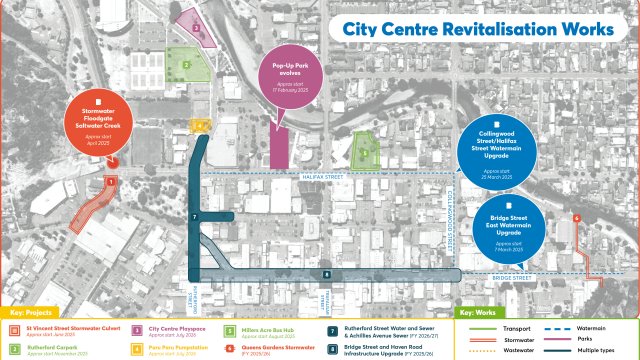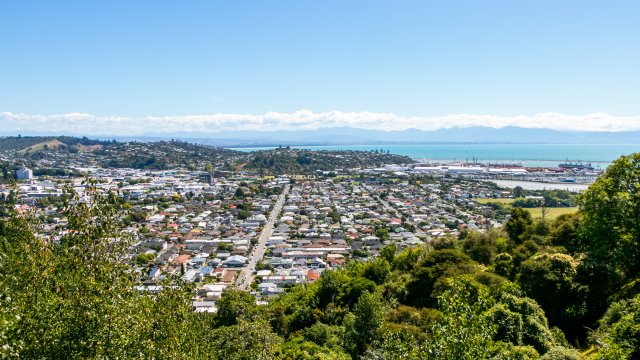Next phase for Bridge to Better project
23/10/2024 12:03pm
A developed design showcasing plans for a vibrant and pedestrian-friendly redesigned streetscape for Bridge Street has been completed.
The multi-million-dollar Bridge to Better project aims to unlock investment and housing opportunities in Nelson’s city centre while addressing critical infrastructure needs and transforming Bridge Street into a vibrant, people-friendly space.
Guided by Te Tauihu Iwi, the design reflects cultural expression throughout, creating a more welcoming, vibrant area for all. Native plantings and cultural design elements will also reinforce Nelson’s identity as a coastal city with strong ties to the natural environment, while artistic Toi Māori features will offer a uniquely Whakatū Nelson experience, instilling pride in local culture.
The developed design is the result of more than a year of investigations and engagement with iwi, businesses and property owners on Bridge Street, and special interest groups including the accessibility community, cycling advocacy groups and emergency services.
City Revitalisation Taskforce Chair, Deputy Mayor Rohan O'Neill-Stevens says completing the developed design marks a key milestone in the journey to revitalise Nelson’s City Centre.
“This project isn’t just about upgrading infrastructure; it’s about shaping a city centre that’s vibrant, resilient, and aligned with the aspirations of our community. The $78 million project, supported by $36.4 million from the Government’s Infrastructure Acceleration Fund, represents the largest Council investment since the Maitai Dam in 1987.
“Bridge to Better is a unique opportunity to create a city centre that works for everyone. By working closely with iwi, local businesses, and residents, and taking on board the feedback we’ve received, we’re ensuring this space reflects the place we live and the values we hold. Beyond the infrastructure, this project will enhance green spaces, create rain gardens, and encourage new investment and housing opportunities. It’s about building a city centre that thrives today and for future generations.”
The plan for Bridge Street includes a flush road surface without kerbs, a wider footpath with additional space for pedestrians, and subtle road realignments to create a safe environment for all users. Key elements of the design, such as car parks, loading zones, accessible parking, trees, rain gardens for stormwater management, and paving layouts, are illustrated in the developed design.
Additional features, including seating areas, cycle racks, rubbish bins and artwork, will also be incorporated into the streetscape. The exact placement and number of these amenities will be finalised in the next phase—detailed design—developed collaboratively with iwi, using the co-design approach used throughout this project. The design also integrates natural elements and functional details inspired by Nelson’s unique environment, further expressing the city’s identity through layout and features.
One of the main elements of the design is the introduction of more than 100 native trees, creating a significantly greener and more welcoming environment for all street users. Although the details are still being finalised, this will require the removal of up to 20 existing non-native trees on Bridge Street and Haven Road to accommodate below-ground infrastructure work and the new road layout.
Infrastructure upgrades beneath Bridge Street, as well as throughout the inner-city streets, will support future development in the city centre, enabling the construction of hundreds of new homes.
The works will include the upgrade of the water ring main (under Bridge Street between Collingwood and Queens Gardens, Rutherford Street, Halifax Street and Collingwood Street), a floodgate for the Halifax Street stormwater outfall into Saltwater Creek, an upgrade of the Paru Paru wastewater pump station, and improvements to the three waters infrastructure beneath Bridge Street.

The developed design with planned underground infrastructure overlay.
The upgrade of three waters infrastructure beneath Bridge Street will considerably increase the size of the pipes currently in place. This includes a new stormwater line with a diameter of 300-450 millimeters, a wastewater line of 300-375mm diameter, a 350mm diameter water main, and a 150 mm diameter water rider main. A network of rain gardens will also be implemented to direct stormwater into the underground pipes.
The design of the upgraded water main and wastewater pipes takes into account the positioning of a historic brick sewer, dating back to around 1867, located beneath this section of the Bridge Street works.
Further community feedback is still being sought on the developed design and Council staff are continuing direct engagement with the businesses and property owners directly affected by the changes. Council welcomes additional feedback about the developed design via Shape Nelson by 30 November 2024.
The engagement process for the Bridge to Better Project has been instrumental in shaping the developed design, incorporating key community feedback, such as:
* Calls to make Bridge Street more climate-friendly, safe, and suitable for cyclists, and a safer, livelier place for everyone, including older people
* A strong desire for the street to be able to host events and maintain a constant buzz
* An emphasis on green spaces and family-friendly environments
* Reducing car traffic to prioritise pedestrians, restaurants, cafes, play areas, and bike lanes, while also retaining access for all forms of transport, including easy access to car parks for takeaway customers.
* Create more inner-city housing so the city centre is vibrant seven days a week.




